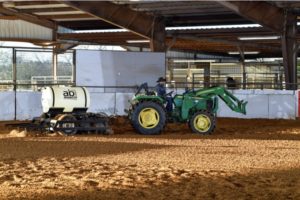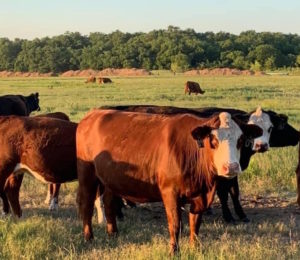
Preparing the arena for
show time. Good ground
is crucial.
You’ve gone to plenty of shows, you’ve seen good ones and not so good ones. But wouldn’t it be great if you didn’t always have to travel? Wouldn’t it be great to grow the sport in your own backyard? While it does take some planning, putting on a show can be a rewarding way to be involved in reined cow horses.
Emily Konkel has been working for the NRCHA for three years, and the Premier Event Manager since February. When thinking about planning a show, she said make sure you know your audience. Make sure there is enough local interest in a cow horse show. The time of year needs to be considered as well as not conflicting with other show dates.
Konkel said the key to putting on a good show is having a good attitude.
“Horse shows are long and intense and very stressful at times. Having a good attitude makes it that much easier and people feed off it. One thing we try to keep in mind is that, for non-pros, a lot of times they are taking vacation days to come to your horse show so we want to make that an enjoyable event for them so they keep coming back,” she said.
To keep the show fun, Konkel said to think about making the event as efficient and hassle-free as possible.
“In Scottsdale, we had early days which made it really nice. People were able to go out to dinner, hang out with friends and go have some drinks. We had tons of kids there so we tried to incorporate some kid events. It’s just getting a feel for your audience and really knowing who you’re working with.”
For example, at events like The Celebration of Champions, which is held when kids are in school, it doesn’t make sense to put on children’s activities.
Konkel recommends having a great team to accomplish all of the tasks needed to run a great show. When getting a show or organization off the ground Konkel said, “If you’ve got the right time of year, right audience, and people that are wanting to show, it will take care of itself.”
Tina McCleary is the treasurer, show manager/ secretary and facility manager for the South Texas Reined Cow Horse Association. A majority of their shows are held at Still Creek Ranch.
The ranch hosts shows as fundraisers. “Our mission is to rescue boys and girls from crisis environments and to restore their lives by placing them in a family-style home environment, and through our accredited boarding school, Bible based counseling, TCAL athletics, fine arts, and our equestrian and agricultural programs,” as stated on the ranch website.
McCleary said the group started out by talking to people to see if there was enough interest in having a show and supporting an organization. Once that is established, the show planning can begin.
Step 1: Create an NRCHA Affiliate.
The NRCHA requires a minimum of 20 NRCHA members to found a local affiliate. Bylaws must be established and insurance obtained. That information then needs to be sent to the NRCHA. McCleary said for almost every venue, you have to have a $1 million insurance policy. Most insurance companies can write that policy, but she prefers to go through an equine specific provider. McCleary said that you have to read the fine print. If an event has cows, insurance companies will label it a rodeo event. A lot of policies have exclusions for rodeo events. “Make sure you have appropriate coverage,” McCleary said because of the liability involved. She said a lot of policies only cover spectators but it needs to cover competitors and livestock as well.
Step 2: Find a facility and come up with a show date.
“We usually have our entire calendar done by September of the previous year and usually I will start booking judges for those shows…I try to have everyone in place and my dates out on my website as soon as we get the approval back,” she added. Once you get a date with the NRCHA, it is your date until you release it. And once you release it, you do so forever and have to try to get it back.
Step 3: Create a social media page, a website and logo to promote the events.
Step 4: Then you need to secure a judge, a scribe, an NRCHA approved show secretary, a bit checker, an announcer, office help, show manager, tractor driver, a cattle handler and cow provider.
“For NRCHA, if it is over $5,000 added, you have to have a videographer.”
Step 5: Get show approval. Figure out what classes will be held, what the fees will be and create a budget.

Then you need a judge, a scribe, and NRCHA approved show secretary, a bit checker, an announcer, office help, show manager, tractor driver, a cattle handler and cow provider.
There are two classes that are required for each show: the Open Bridle and Open Hackamore. These two events have to have $250 added. The show can have as many other classes as desired. There needs to be a total of $1000 added for the whole show, so the remaining $500 can be paid out as needed across the other classes.
Balance the Budget
The key to putting on a good show is “Listening to your patrons, listening to your competitors but also knowing you can’t please everyone. If the numbers don’t add up it doesn’t matter how many people you have there. You have to make sure you are covering the business as well as keep numbers low enough that you’re being as fair as you can be to your [show participants]. It’s a constant balancing act,” McCleary said.
As far as finances go, it’s important to also include end of the year prizes so there is enough profit to cover those awards.
McCleary said they have a dinner at every show. They potluck sides and everyone really enjoys the time together sharing a meal.
Efficiency is Key
The key to running an efficient show is pre-planning. McCleary said she has a great crew helping her who are very experienced at their jobs.
“We try to use the same people as much as we can so it’s not a learning curve for every horse show and that helps a lot. We all carry radios and we try to stay up [to date] on everything. We have an announcer that is really good at keeping tabs on things so when I am busy in the office they can keep the arena going. They know all of the ins and outs…”
She said the gate and cow pen help are the biggest keys to keeping the show running on time. They keep riders moving in and out of the show arena and they can move cattle in and out of the arena efficiently.
The class structure is similar from show to show because of the order the cattle are used. For example, a cow cannot be boxed and then go down the fence but a cow can work out of the herd and then go down the fence. They try to use each cow twice. The cattle fee covers the cow transportation, the feed and cattle pen help. The number of cattle needs to be just enough.
McCleary said make sure the drags, lunch breaks and open arena times are posted so everyone knows what is going on and when. Having staff that know their job with a friendly, knowledgeable attitude goes a long way. “They have a huge impact on the perception of the competitor,” McCleary said.
Also, make sure the judge is well qualified. For a complete overview of all of the rules and regulations, see the NRCHA Manual.
